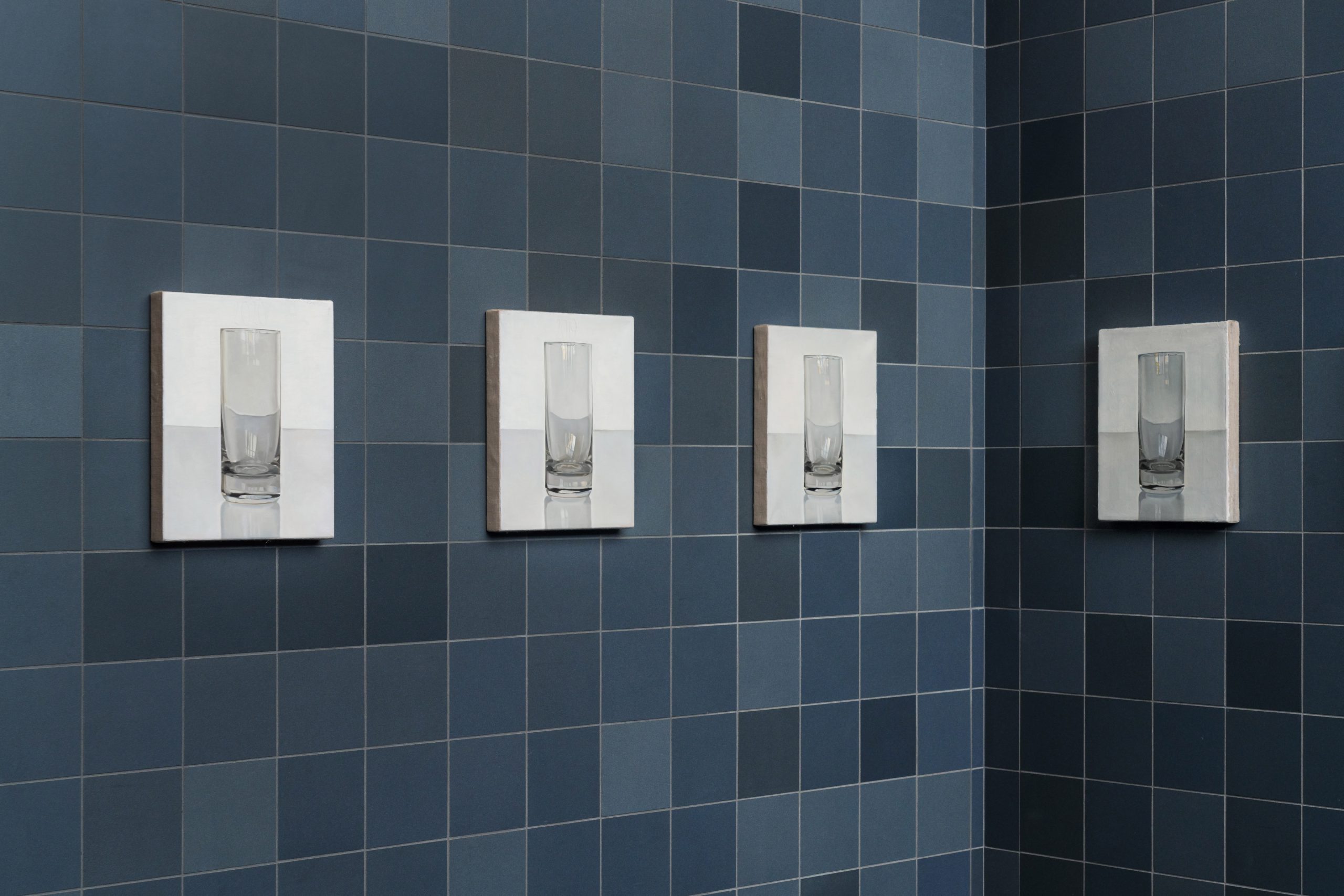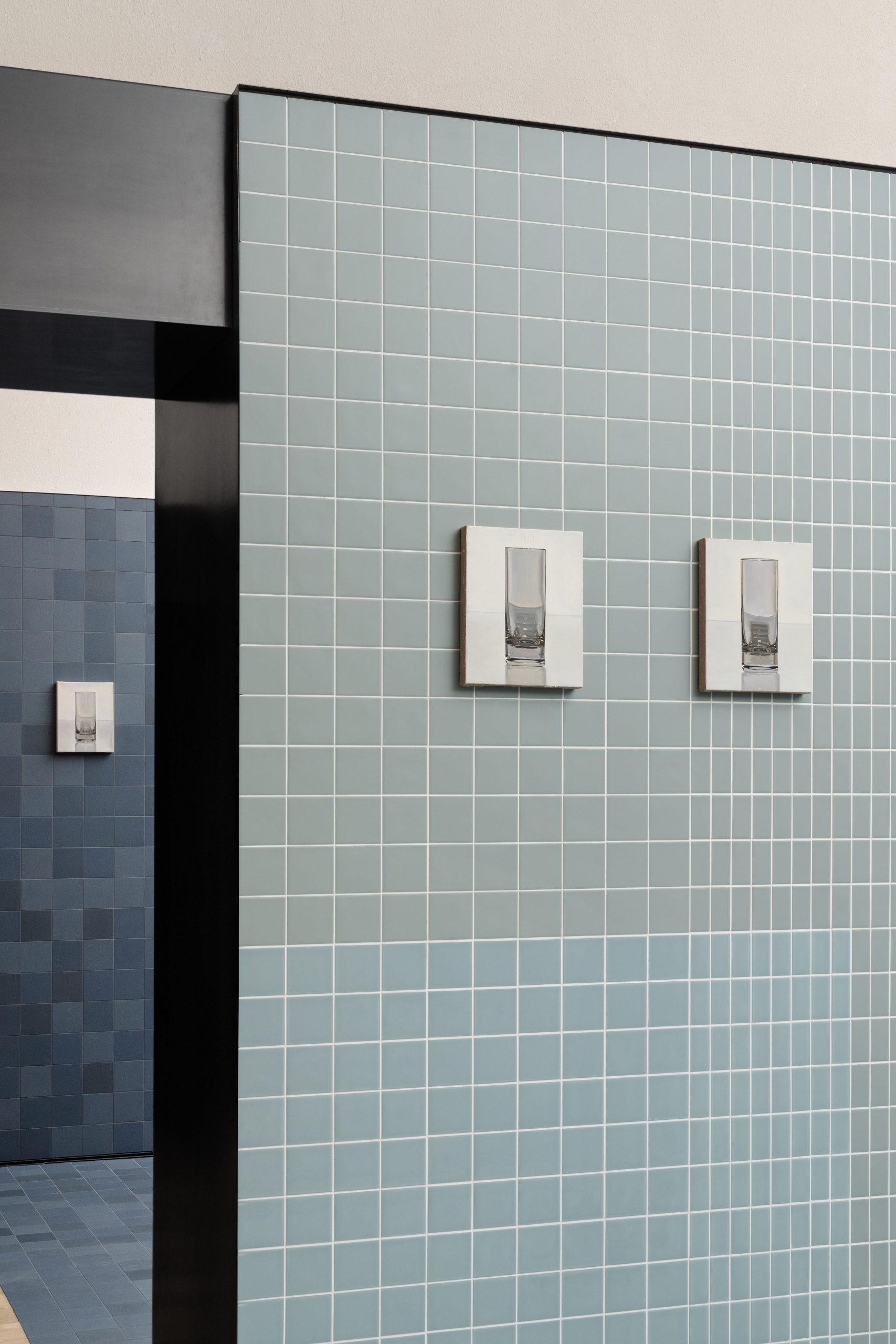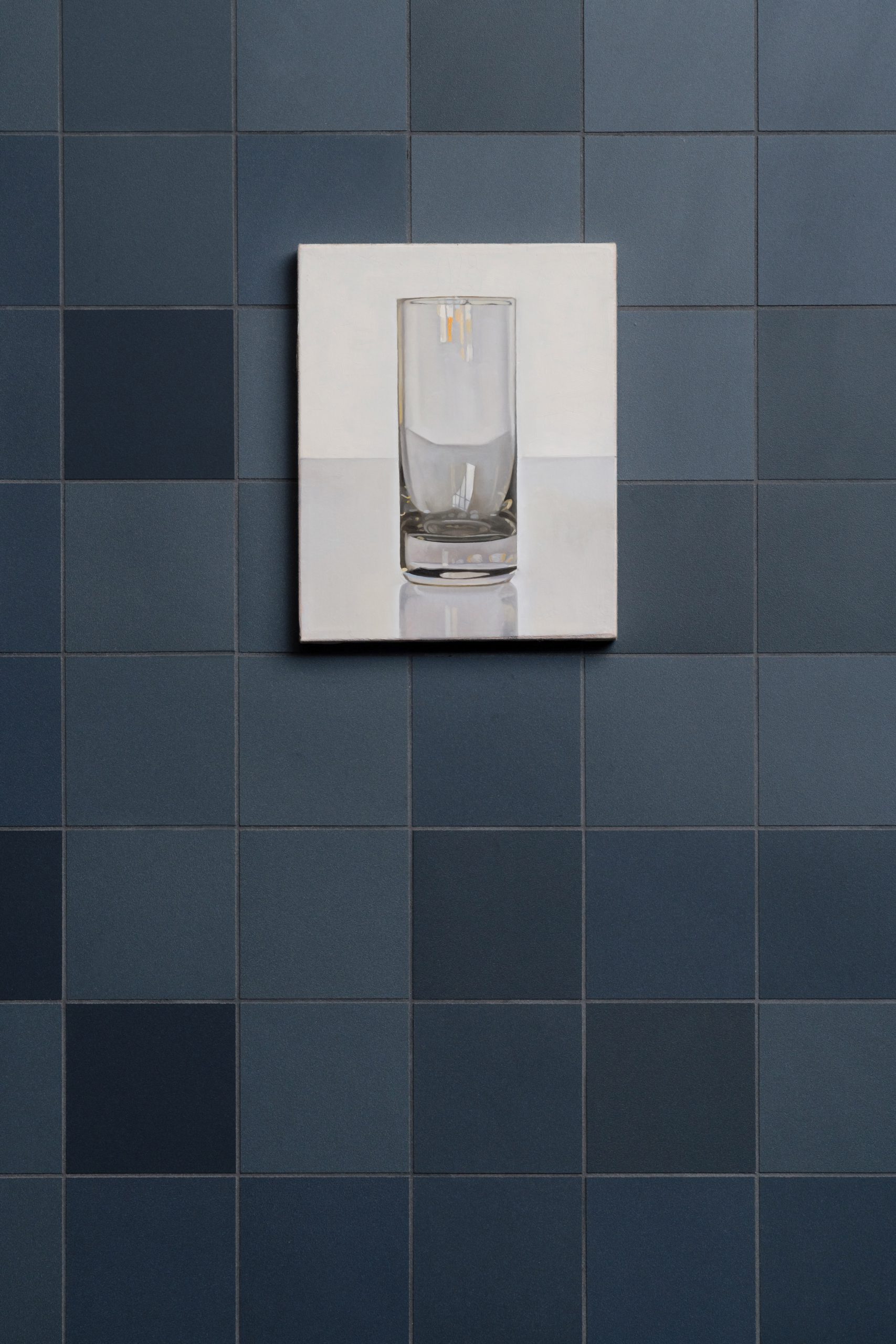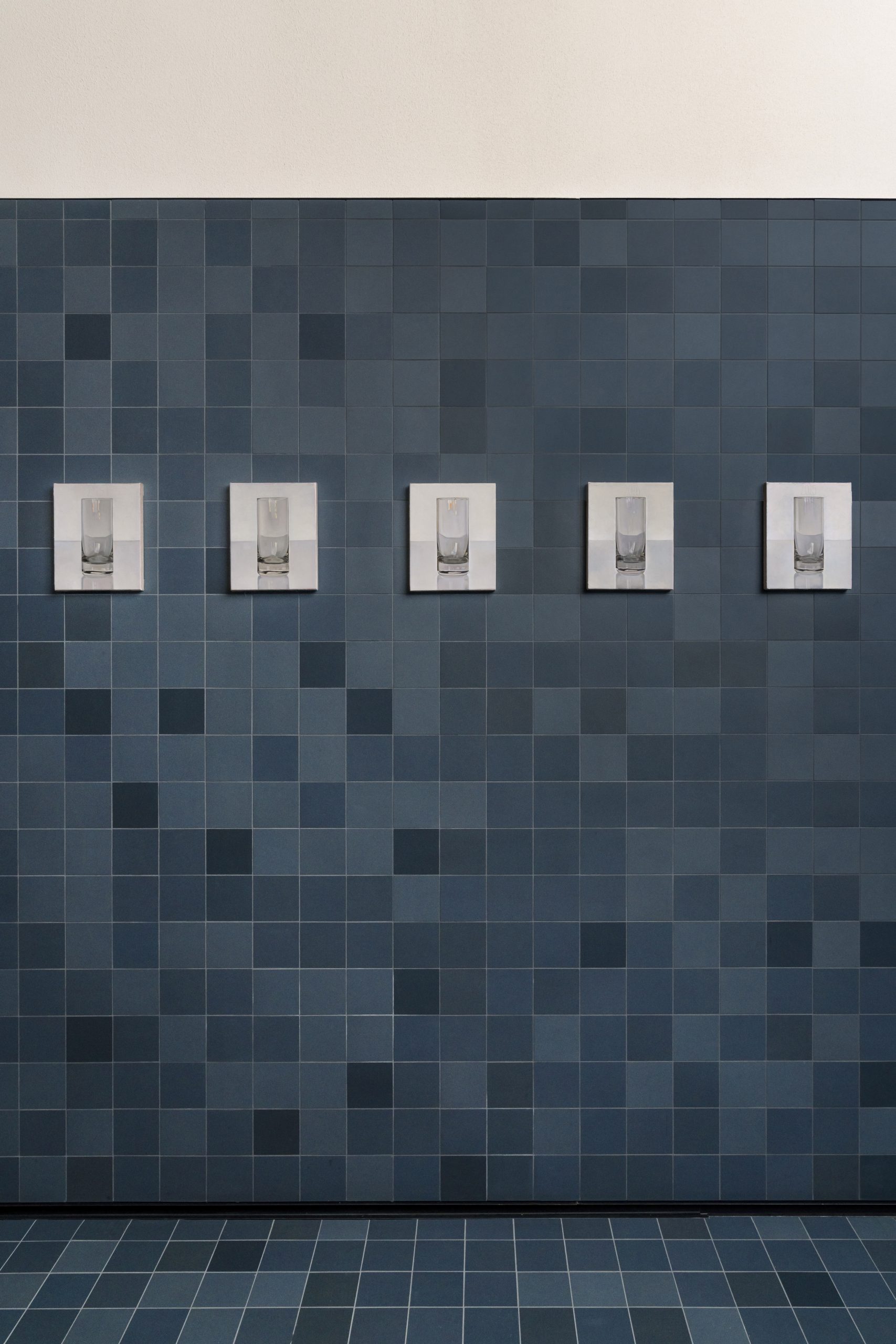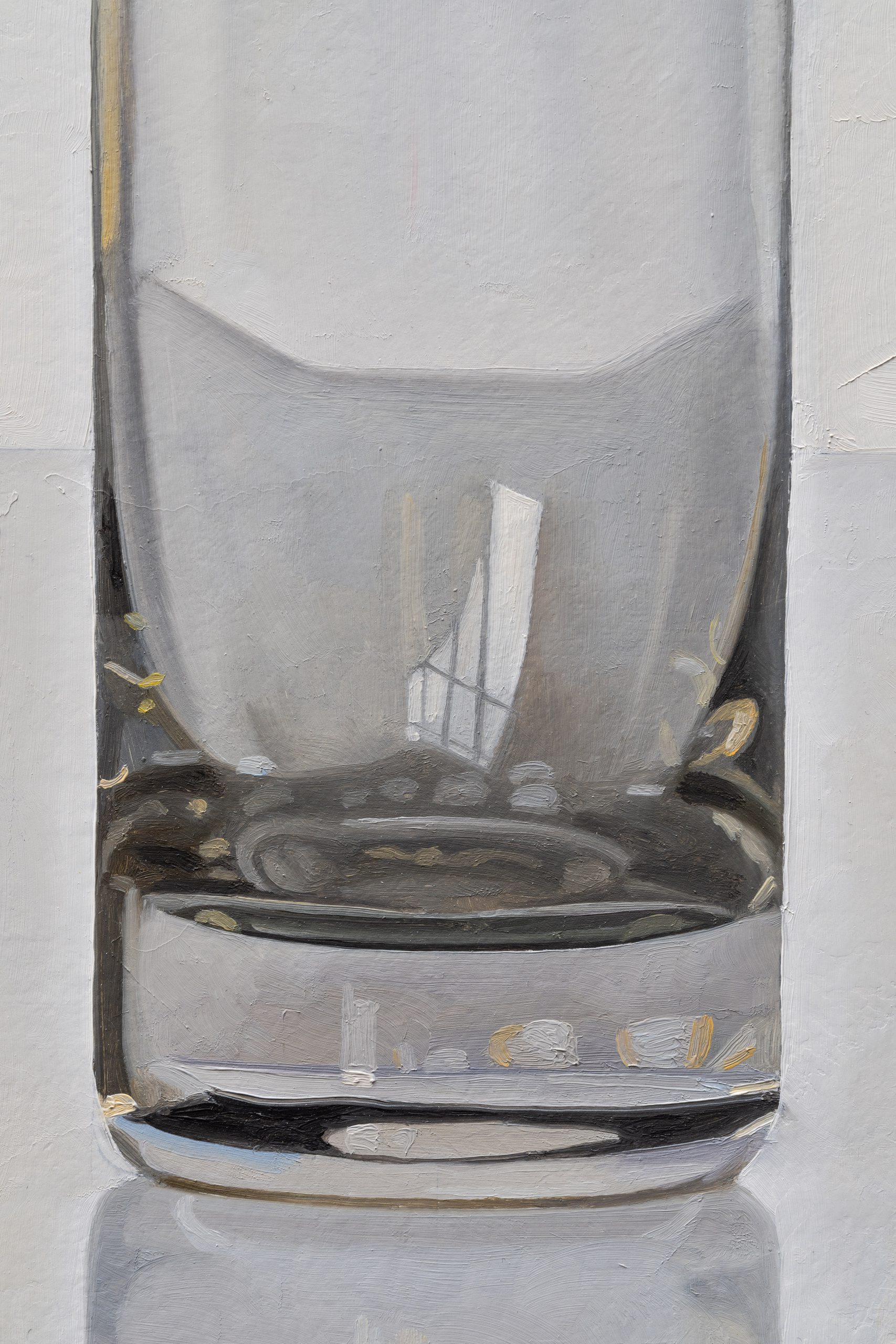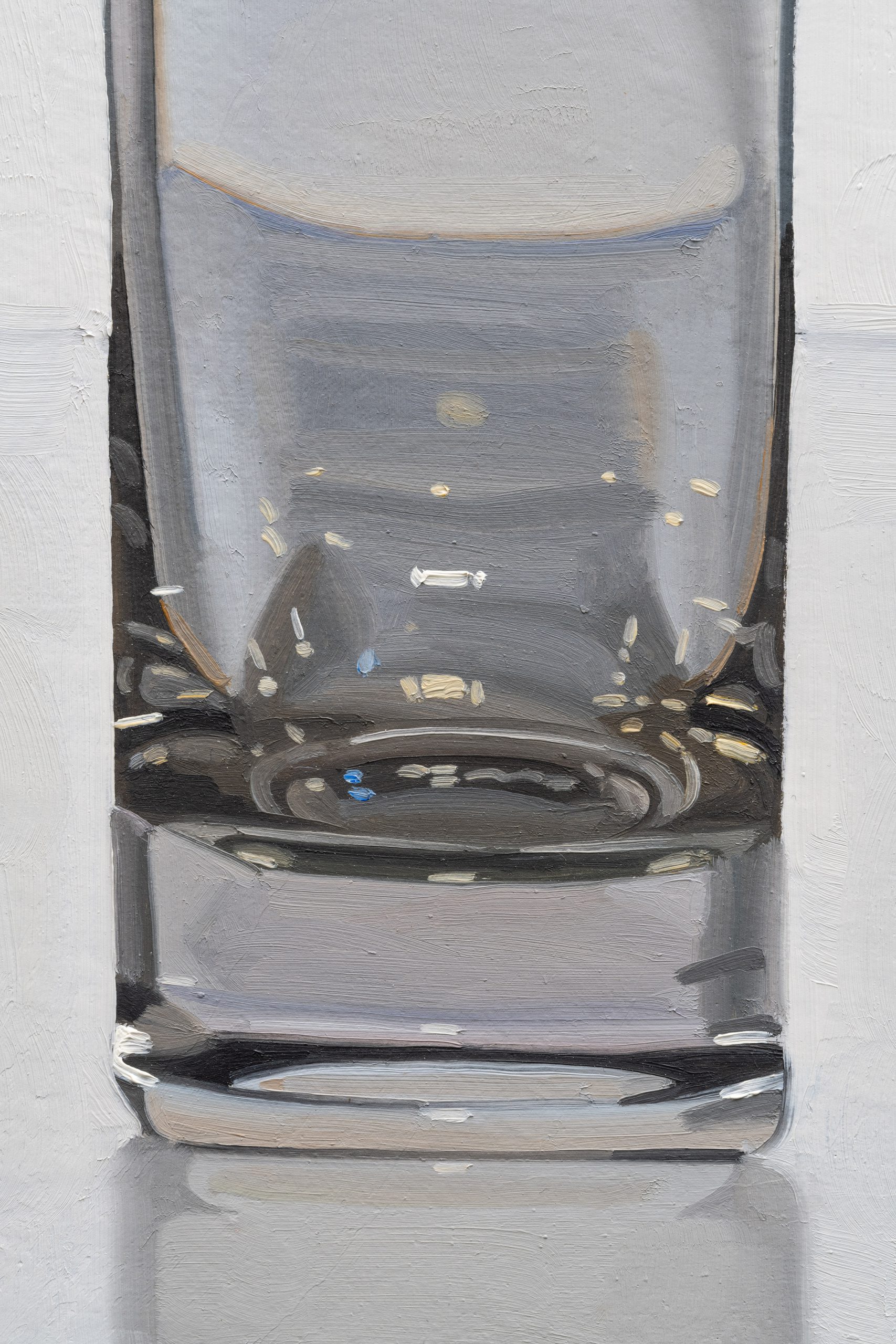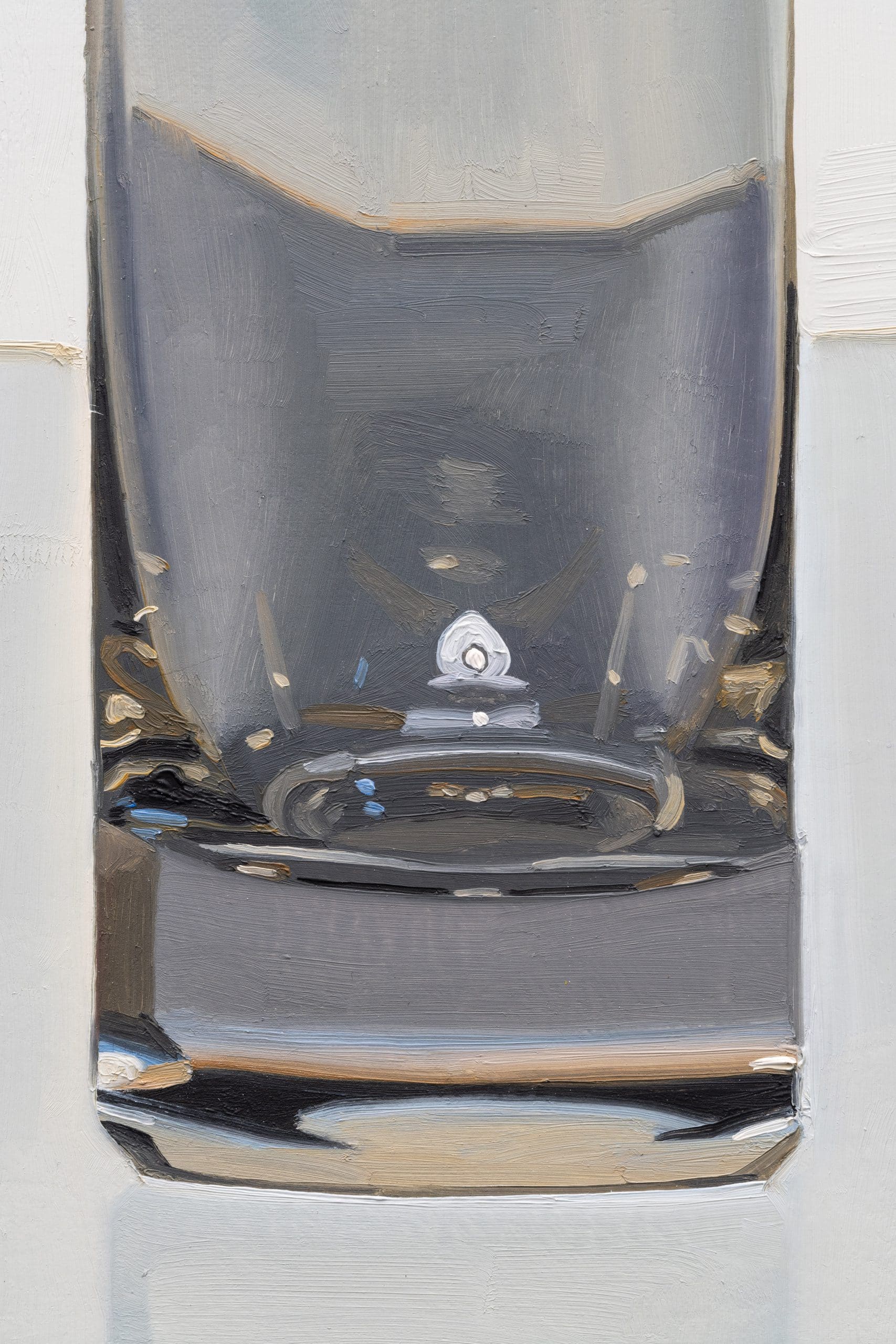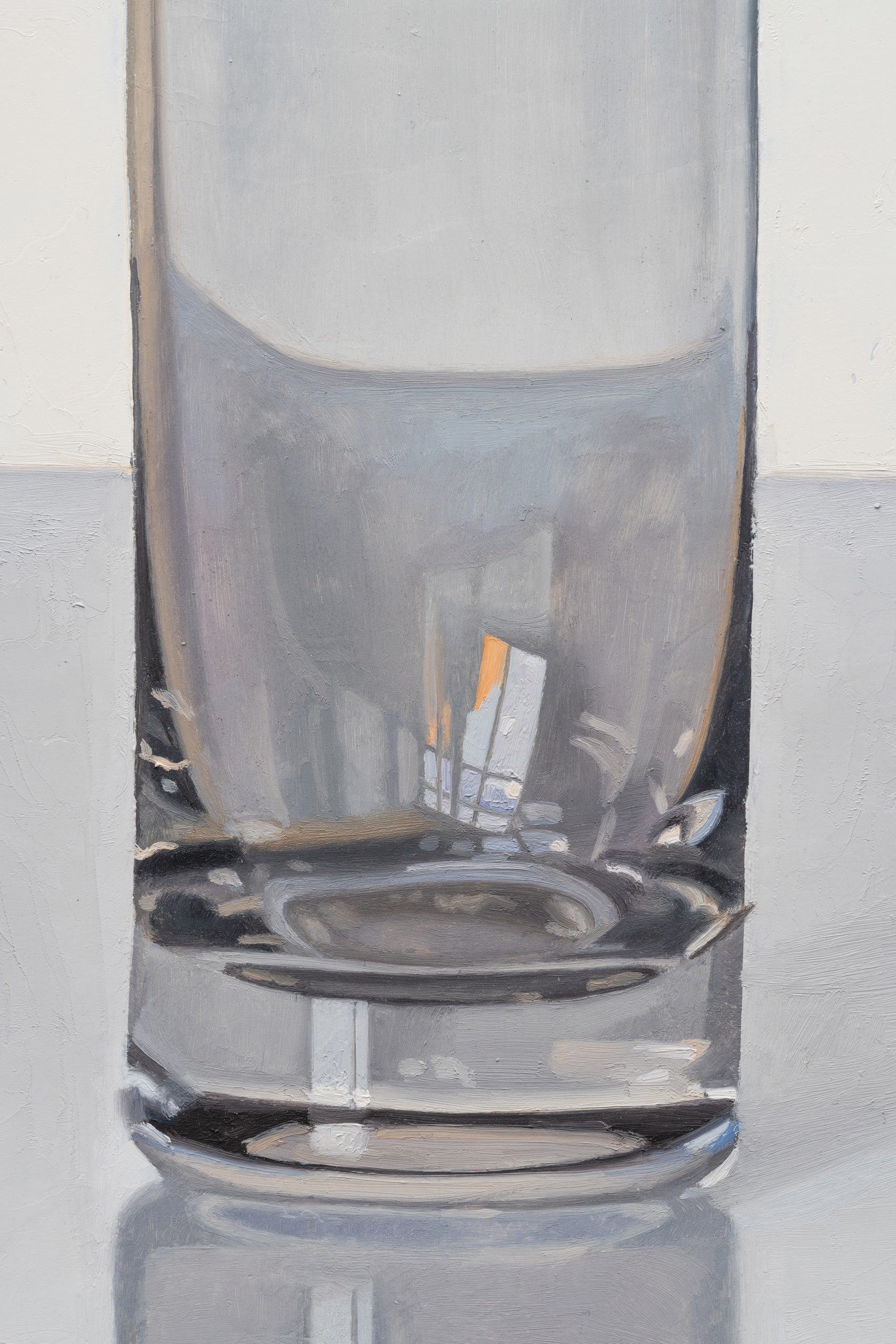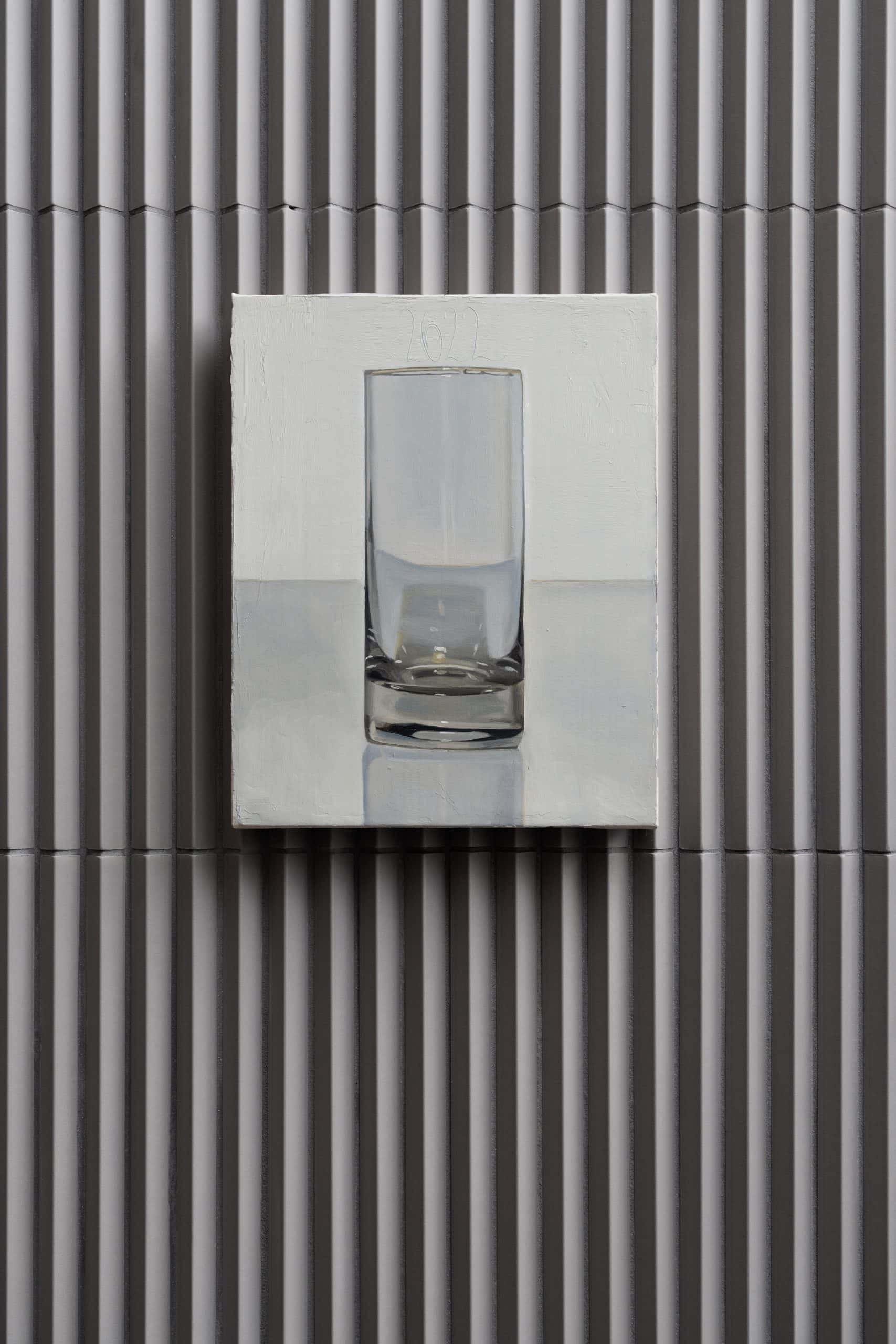Forty years have passed since Peter Dreher began painting the same empty glass of water. Through night and day, with sunsets and sunrises, the same object is criss-crossed by different shadows and lights: smoking signals coming from the juxtaposition of the clouds and the sun, from small artificial lights, large windows, wind and rain. The series Day by Day, Good Day consists of around 5,000 paintings created between 1974 and 2019, all of which depict the glass at the same distance and on canvases of the same size.
Repetition is often seen as a defining characteristic of painters, from the Italian botteghe of the Renaissance to modern studios near industrial areas. However, while repetition has been a fundamental aspect of their craft for centuries, its meaning and significance have evolved over time. This text argues that in the 1970s–when Dreher began his work–repetition could be viewed as a means of democratisation in response to a war that had highlighted how the world was controlled by only a few. My starting point will be an exhibition held in Milan in recent months, which recalls Dreher’s work in a different light, far from the image of the artist linked to the auction market with which we have come to associate him in recent years.
Dreher was born in Mannheim, Germany, in 1932 at the same time as many of the exponents of German Abstract Expressionism. However, his approach to art was very different from that of his generation. Between abstraction and expression, he opted for hyper-realism and depicted small objects belonging to his everyday life. He viewed painting as an anti-semantic act: the idea was to free the pictorial gesture from any subjective form of meaning, experience, narrative or prior knowledge. Anything that could influence the narrative was removed from his work.
He even differed greatly from artists such as On Kawara and Roman Opalka, who used repetition to frame time. Kawara, a Japanese artist who lived and worked in New York, used mail art to document his daily life, sending updates on mundane activities to his family, such as I Woke Up at Nine and I’m Still Alive. In Date Paintings series (1966), he painted the current date on a monochrome canvas every day in the language of the country he was in and combined each artwork with a newspaper clipping from that day. Similarly, Roman Opalka painted a numerical scale from one to infinity everyday and, after completing the gesture, took a photograph of himself.
These two artists explored the concept that time represents both decay and the portrayal of an everlasting present, where the gesture remains constant, while the means and context of that same gesture inevitably change over time. Anyway, unlike Kawara and Opalka, time didn’t interest Dreher, nor did he choose an object which was actually subject to the flow of time. According to curator Sarah Cosulich, Dreher’s repetition is less mechanical than that of his contemporaries. The artist did not adhere to a strict schedule, as he did not paint every day during his forty-year career, nor did he show interest in scheduling his painting.
I would say that Dreher’s work is more than anything else a diary of failure, as it does the opposite of what it claims to do: it shows the inability to exclude subjectivity from painting. In fact, despite the artist’s attempt to impose objectivity by choosing a meaningless object such as a glass, this object is still made of a material that reflects reality. Indeed, upon closer examination of the canvases in Day by Day, Good Day, recurring elements become apparent on the surface of the empty glass: an open or closed window, a night lamp, some stairs and curtains. In this sense, looking at the same water glass is like looking through the peephole of Dreher’s door, involuntarily witnessing a small glimpse into his studio and his reality. Not only has this glass reflected everything surrounding the painter for forty years, but the painter’s gesture itself changes from canvas to canvas, according to his age, his craftsmanship and his vision.
It would take more than forty years to fully comprehend the various artistic responses to the aftermath of World War II. However, as seen in Malevic’s black painting and John Cage’s silence, at one point there was a clear focus on achieving a degree zero in painting, sculpture and music. It is important to note that this iconoclastic behaviour was not a nihilistic rejection of the reality of representation, but rather a search for a neutral starting point in order to build a new one. Cage concluded that true silence may not exist. Similarly, Klein’s void was an act of trickery, and Malevic’s black square, rather than a vacuum end, has been the beginning of many different assemblable forms and of a new movement in painting. In essence, they realised that absence of meaning–the so-called zero degree in art – could be seen as the beginning of many different meanings. As Dreher’s glass acts as a canvas, the void can serve as a matrix for many different icons. How can the sound of silence be conveyed? How to make everyday objects extraordinary? By simply putting a frame around them. In Day by Day, Good Day, the empty glass serves as that frame.
It is no coincidence that both Cage, Klein and Dreher were all close to oriental philosophies, especially Zen Buddhism. For those who, after the wars, no longer believed in Western values such as individualism, subjectivity and fragmentation, these philosophies offered a refuge in the wilderness, a new way of experiencing the world. The quest for a void of meaning in the arts is a direct result of these worldviews. According to Zen philosophy, the body had to be freed from individuality and claims to knowledge. The world had to be experienced as a tangle of chaos, where even the act of painting or composing is not a responsibility or a choice, but an acceptance of what is naturally happening around you. In a way, the shift from doing to accepting and mirroring what is happening appears to be the real purpose behind the choice of an empty glass as the subject of painting.
There is something else that aligns Dreher’s practice with contemporary thinking, making an exhibition of his work still relevant. His use of repetition rejects a common notion: the one of the artist as a more-than-gifted individual driven by the mysterious working of the unconscious mind, instead promoting collectivism and anonymity over individualism. Artists like Dreher seem to say: “Not only can everything be art and everyone be an artist, but we artists may be even more ordinary than you.” This is a strong departure from the prevailing view of artists in the 1970s, when many considered them to be mythological figures leading extraordinary lives. Examples were everywhere: Joseph Boys, Yves Klein, Piero Manzoni and James Lee Byars. But not for Dreher: for him there was no myth to construct, no identity to build around the artists. For him, art could be reduced to the single, repetitive and common gesture of painting.
With this exhibition in memory of Peter Dreher, a design brand like Mutina is interestingly highlighting repetition as a poetic act rather than a commercial or productive choice. Peter Dreher, like many artists whose work is based on repetition, was concerned with ordinary life, with what might happen in the most anonymous house on the most anonymous day ever. This attention to the way people live brings Dreher’s work into line with the ancient principles of the practice of design. As we said, in the ‘70s, when art was becoming more of a reputational work than a concrete act, many artists took a different path, exchanging fame for communality. The same thing happened in the world of design.
It has surely been over forty years since the concept of democratising art was first discussed and it is unclear whether any progress has been made in this regard. However, recontextualising artworks from the past to meet the pressing needs of the present could be the most irreverent yet useful gesture to put art into a democratic perspective. For instance, consider reframing repetition not as simply training to improve painting skills, but as a socially-engaged activity.
The exhibition 100 Days at Casa Mutina in Milan is part of a series of exhibitions which aim at connecting the ceramic surfaces of Mutina with works of contemporary and established artists worldwide. Curated by Sarah Cosulich, the exhibition showcases one hundred of Dreher’s paintings made between 1983 and 2021 on ceramic tiles that dot the walls of five rooms. The regular and modular rhythm of the tiles echoes the painter’s gesture, repeated in a domestic environment. The ceramic surfaces, like Dreher’s empty glass, reflect the everyday changes occurring in a particular space. They both act as that small peephole through which we can find significance in the ordinary things.
